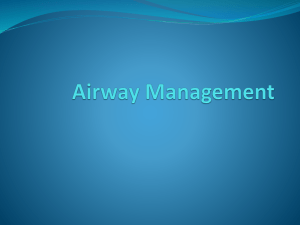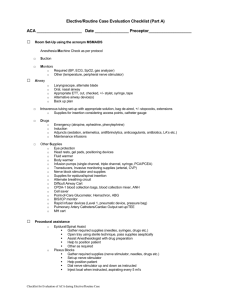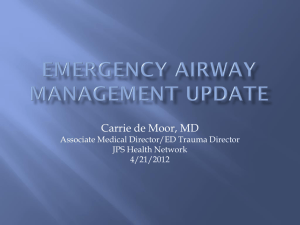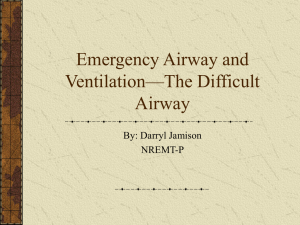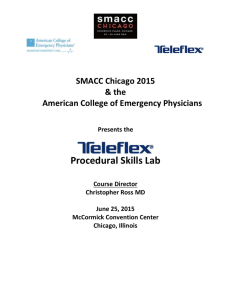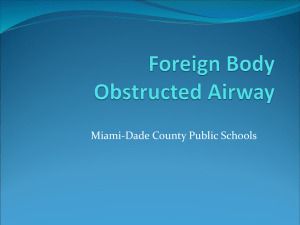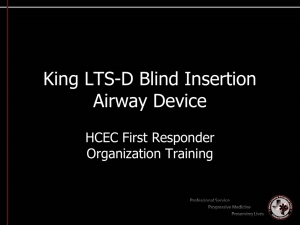Surgical Airways
advertisement
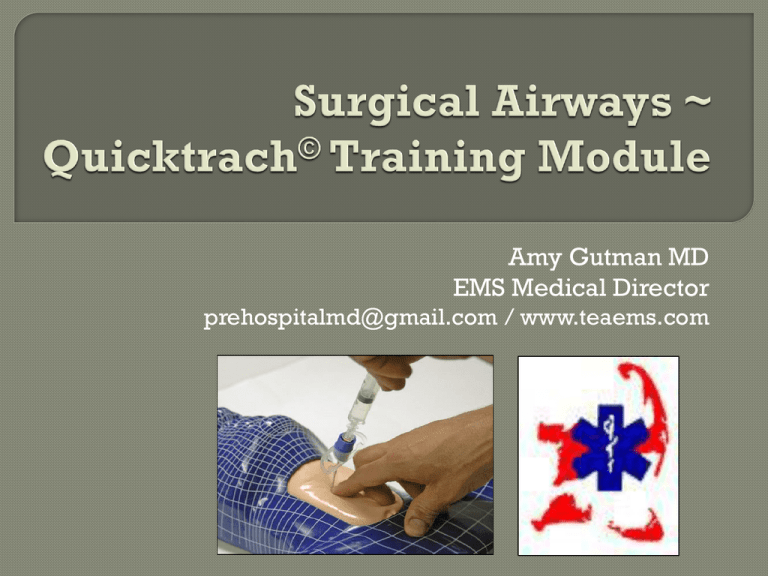
Amy Gutman MD EMS Medical Director prehospitalmd@gmail.com / www.teaems.com Surgical airway indications Airway anatomy review QuickTrach© policy & procedures Utilizing a surgical airway “assumes” provider followed the Difficult Airway Pathway & “Cannot Intubate, Cannot Ventilate” QuickTrach© is a rapid, safe & reliable surgical airway device Prehospital emergency cricothyroidotomy rare As with all rarely performed skills, after initial training, regular re-training required Creation of an opening in space between thyroid cartilage anterior-inferior border & cricoid cartilage anterior-superior border to access the subglottic airway Allows endotracheal tube placement when airway control not possible by other methods Can’t Intubate, Can Ventilate • 2 unsuccessful advanced airway attempts (ETI, supraglottic) • BVM maintains O2 sat >90% Can’t Intubate, Can’t Ventilate • 2 unsuccessful intubation attempts (ETI, supraglottic) • Cannot maintain O2 sat >90% with BVM ETI / NTI Alternatives: Biluminal LMA Combitube Lighted Stylette Unsuccessful Successful Cricothyrotomy Or Retrograde Successful Post Airway Management • • • • L E M O N Look Externally Evaluate 3-3-2 Mallampati Obstruction Neck Mobility • • • • • M O A N S Mask Seal Obese Aged > 55yo No Teeth Snores / Stiff Three Basic Steps: • Insert, Inflate, Secure Sterile sets pre-assembled for immediate use Needle tip reduces bleeding risk Stopper prevents needle from being inserted too deep reducing risk of tracheal perforation Neck-tape allows fast fixation • Infants (1.5mm) • Children (2mm) • Adults (4mm) • Uncuffed • Larger Children & Adults (4mm) • Cuffed 1.5mm infant • <3 yo 2mm pediatric • <100 lbs 4mm size adult • >100 lbs Kits look similar except for length Massive trauma to larynx or cricoid cartilage Damage to affected structures make it impossible to perform procedure properly Alternative or less invasive maneuver allows ventilation Hemorrhage Esophageal perforation Tracheal perforation Tracheoesophageal fistula Infection / Abcess Subcutaneous air Place patient supine with neck slightly extended • In-line stabilization if cervical trauma suspected Locate cricothyroid membrane midline between thyroid cartilage (Adam’s apple) & cricoid cartilage Prep overlying skin Palpate thyroid & cricoid cartilage for orientation • A: Cricoid Cartilage • B: Cricothyroid Membrane • C: Incision Site • D: Thyroid Cartilage Puncture cricothyroid membrane at 90° angle Confirm needle entry into trachea by aspirating air Change hand angle to 60°; slide catheter sheath forward to stopper hub level Advance plastic cannula as you remove needle & syringe • If cuffed, then inflate with 2-3cc Begin ventilation when needle & syringe removed http://www.youtube.com/watch?feature=player_de tailpage&v=waHwm7QQ17M Ventilate patient, observing for chest rise & fall Auscultate for BL breath sounds • If absent, ETT may be in neck subcutaneous fascia or esophagus • Remove & attempt to re-insert Secure device Continuous evaluation & documentation of oxygen saturation, ETCO2, vitals Notify ED of Priority 1 patient Maine Department of EMS. “Advanced Airway Training”. 2010 S Hopkins RN. “Equipment Review”. Condell Medical Center EMS System. 2008 CPT A Proulx, MPAS, PA-C. “Airway Management in the Combat Casualty”. 2011 Emergency Medicine: A Comprehensive Study Guide, Tintinalli, 6th ed, Mcgraw-Hill, 2004 www.myrusch.com Ron Walls Difficult Airway Management Text (2011) Difficult Airway Site (www.theairwaysite.com) Well-documented success in prehospital, military & other emergency settings 3 Basic Steps ~ Insert, Inflate, Secure Reduced time to advanced airway placement in critical patients who cannot be ventilated Rapid, safe & effective method of providing a definitive airway



